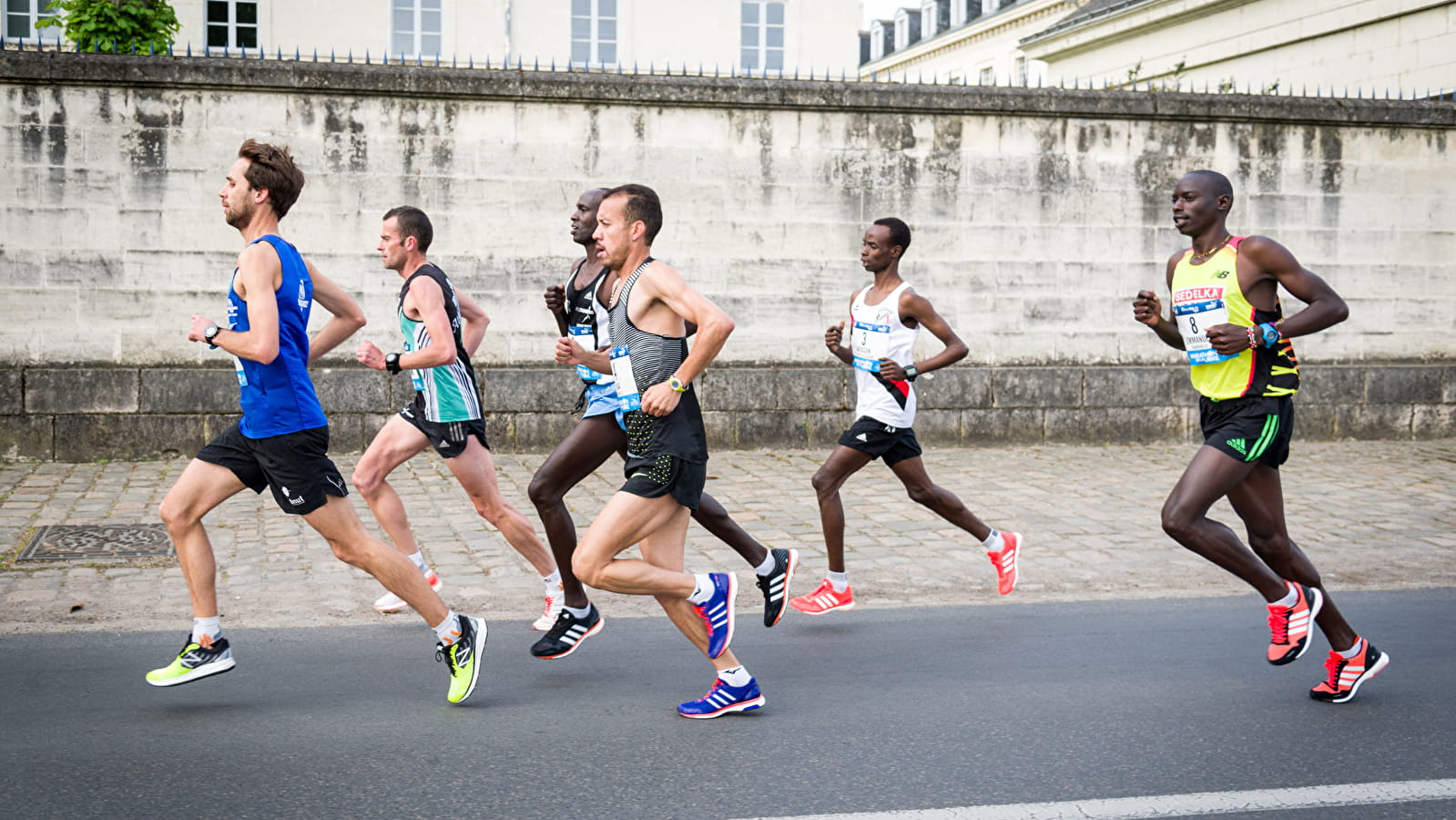Home>Misc>Featured>Why Are Skinny People Good At Long Distance Running


Featured
Why Are Skinny People Good At Long Distance Running
Modified: August 21, 2023
Discover the fascinating link between being skinny and excelling in long distance running. Read our featured article on why these individuals have a natural advantage in endurance sports.
Introduction
It’s no secret that some individuals seem naturally predisposed to excel in certain athletic endeavors. When it comes to long-distance running, it’s not uncommon to see skinny individuals dominating the sport and achieving remarkable feats. But why is it that skinny people often have an advantage in long-distance running?
To understand this phenomenon, we need to delve into the physiology of skinny individuals and explore the various factors that contribute to their success in this particular discipline.
Before we begin, it’s important to note that when we refer to “skinny” individuals, we are referring to those with a lean and slender physique, typically characterized by low body fat and a relatively smaller overall frame. While body type alone does not guarantee success in long-distance running, it is certainly an attribute that can provide several advantages.
In this article, we will explore the physiological, biomechanical, and psychological factors that contribute to the success of skinny individuals in long-distance running. From muscle fiber composition and body composition to oxygen consumption efficiency and training habits, we will examine the intricate interplay of these factors and how they give skinny runners an edge in this demanding sport.
It’s important to note that while this article will shed light on the advantages of skinny individuals in long-distance running, it should not be interpreted as a statement that only skinny people can excel in this sport. Hard work, dedication, and a well-rounded training regimen are key components of success in any athletic pursuit, regardless of body type.
Now, let’s dive into the fascinating world of long-distance running and explore why being skinny can be a significant advantage in this sport.
The Physiology of Skinny People
When it comes to long-distance running, the physiology of the individual plays a crucial role in determining their success. Skinny people tend to have certain physiological characteristics that give them an advantage in this demanding sport.
One of the factors that contribute to the success of skinny individuals in long-distance running is their muscle fiber composition. Research has shown that individuals with a high proportion of slow-twitch muscle fibers have better endurance capabilities. Slow-twitch muscle fibers are responsible for sustained contractions and are more resistant to fatigue. Skinny individuals often have a higher proportion of these fibers, allowing them to maintain a consistent pace over long distances.
Another aspect where skinny people excel is their body composition. With lower levels of body fat, they have less weight to carry, which reduces the strain on their joints and muscles during prolonged running. Additionally, their lean body mass allows for efficient energy expenditure, maximizing their running economy.
Oxygen consumption efficiency is another physiological advantage that skinny individuals possess. They often have a higher maximal oxygen uptake, commonly known as VO2 max. This means that their bodies are efficient at utilizing oxygen during exercise, delivering it to the muscles more effectively. As a result, skinny people can sustain a higher pace and delay the onset of fatigue.
Heat dissipation is also a critical factor in long-distance running, especially in hot and humid conditions. Skinny individuals have an advantage in this regard, as their smaller body size and compact build allow for better heat dissipation. This helps them regulate their body temperature more effectively, preventing overheating and allowing them to maintain a steady pace for longer.
From a biomechanical standpoint, skinny runners often exhibit better running economy. Their lighter body mass, combined with efficient stride length and frequency, enables them to utilize energy more effectively. This means they can cover more ground with less effort, conserving energy for the later stages of a race.
While physiology certainly plays a crucial role, it’s important to note that success in long-distance running is not solely determined by these factors. Psychological factors, training habits, and other variables also play a significant role in achieving peak performance.
Now that we’ve explored the physiological advantages of skinny individuals in long-distance running, let’s delve deeper into the other factors that contribute to their success.
Muscle Fiber Composition
When it comes to long-distance running, the composition of muscle fibers in the body plays a vital role in determining an individual’s endurance capabilities. Skinny people tend to have a specific muscle fiber composition that gives them an advantage in this sport.
In the human body, there are two main types of muscle fibers: slow-twitch (Type I) fibers and fast-twitch (Type II) fibers. Slow-twitch muscle fibers are geared towards endurance activities, while fast-twitch fibers are better suited for power and explosive movements.
Research has shown that individuals with a higher proportion of slow-twitch muscle fibers tend to excel in long-distance running. These fibers are characterized by their ability to sustain contractions over extended periods and are more resistant to fatigue.
One key advantage of having a higher percentage of slow-twitch muscle fibers is the ability to maintain a consistent pace throughout a race. Skinny individuals often possess a larger proportion of these fibers, which allows them to sustain prolonged efforts without experiencing a significant decline in performance.
Additionally, slow-twitch muscle fibers rely predominantly on the aerobic energy system, using oxygen as their primary source of fuel. As a result, they are better equipped to utilize fat as an energy source, which is essential during prolonged aerobic exercise such as long-distance running. This efficient utilization of fuel allows skinny individuals to sustain a steady rhythm and endure for longer periods.
In contrast, fast-twitch muscle fibers are better suited for short bursts of intense activity. They rely more on anaerobic energy systems and quickly fatigue due to the build-up of lactic acid. While fast-twitch fibers are advantageous in sports that require explosive power, they can be a disadvantage in the context of long-distance running.
It’s important to note that muscle fiber composition is not solely determined by body type, and individuals can train to some extent to modify their fiber type distribution. However, genetics do play a significant role, and skinny individuals tend to have a higher proportion of slow-twitch muscle fibers naturally.
Although muscle fiber composition is just one piece of the puzzle, it is a crucial factor in explaining why skinny individuals often excel in long-distance running. Their bodies are genetically inclined towards endurance activities, enabling them to sustain prolonged efforts and maintain a consistent pace throughout a race.
Now that we’ve explored the impact of muscle fiber composition, let’s move on to the next aspect of why skinny people are good at long-distance running – body composition.
Body Composition
When it comes to long-distance running, the body composition of an individual can play a significant role in their performance. Skinny individuals, with their lean body mass and low body fat percentage, often have a distinct advantage in this sport.
Having a lower body fat percentage is advantageous for several reasons. First, less body fat means less weight to carry, reducing the strain on joints and muscles. This is particularly important in long-distance running, where every extra pound can make a difference. The lighter body mass allows for more efficient movement and reduces the energy required to propel oneself forward, leading to improved running economy.
Additionally, having less body fat means a higher proportion of lean muscle mass. Lean muscle is not only responsible for generating power and propulsion but also plays a crucial role in maintaining running form and stability. The presence of excess body fat can hinder a runner’s biomechanics and posture, leading to inefficiencies and potential injury risks.
Another aspect related to body composition is the distribution of weight. Skinny individuals often have a more compact and proportionate physique, which aids in balance and agility. This balance is especially important in distance running, where maintaining good form and stability is key to preventing fatigue and optimizing performance.
Furthermore, having a lower body fat percentage is associated with improved health markers and cardiovascular fitness. It reduces the risk of various health conditions and allows for better oxygen delivery to muscles during exercise. This enhanced oxygen transport is crucial in long-distance running, as it delays the onset of fatigue and allows individuals to sustain a higher intensity for a longer duration.
It’s important to note that body composition is not solely determined by genetics or body type. Training habits, nutrition, and lifestyle choices also play a significant role in shaping one’s body composition. However, skinny individuals generally have a natural advantage due to their genetics and inherent body type.
While body composition is just one aspect of why skinny people excel in long-distance running, it underscores the importance of having a lean physique with a low body fat percentage. It reduces the physical demands on the body and allows for optimal performance, efficiency, and endurance.
Now that we’ve explored the impact of body composition, let’s move on to the next aspect of why skinny individuals are good at long-distance running – their oxygen consumption efficiency.
Oxygen Consumption Efficiency
In the world of long-distance running, the efficient utilization of oxygen is crucial for sustained performance. Skinny individuals often possess a higher level of oxygen consumption efficiency, allowing them to excel in this demanding sport.
Oxygen consumption efficiency is commonly measured by an individual’s maximal oxygen uptake, known as VO2 max. This refers to the maximum amount of oxygen that the body can utilize during intense exercise. Research has shown that skinny individuals often have higher VO2 max values compared to those with a higher body mass index (BMI).
One reason behind this higher oxygen consumption efficiency in skinny individuals is their improved cardiovascular system. With a smaller body mass to perfuse, their heart doesn’t have to work as hard to pump oxygenated blood to the muscles. This efficient oxygen transport improves endurance and helps delay the onset of fatigue during long-distance running.
Besides the cardiovascular system, smaller body size and reduced weight also contribute to better oxygen utilization. When running, every step involves the muscles consuming oxygen to generate energy. With a smaller body to support, the oxygen demand is relatively lower, allowing skinny individuals to sustain higher paces for longer durations.
Further supporting their oxygen consumption efficiency, skinny individuals often have a higher concentration of red blood cells, which are responsible for carrying oxygen to the muscles. The increased red blood cell count in skinny individuals enhances their oxygen-carrying capacity and therefore their endurance capabilities.
Additionally, skinny individuals tend to have a higher capillary density in their muscles. Capillaries are tiny blood vessels that surround the muscle fibers and facilitate the exchange of oxygen and waste products. The higher capillary density in skinny individuals allows for a more efficient delivery of oxygen to the working muscles, further enhancing their endurance performance.
While oxygen consumption efficiency plays an essential role, it’s important to note that training and lifestyle choices also impact an individual’s VO2 max. Regular aerobic exercise, such as running, can improve VO2 max regardless of body type.
In summary, skinny individuals often exhibit higher oxygen consumption efficiency due to factors such as improved cardiovascular function, smaller body size, increased red blood cell count, and higher capillary density. These physiological advantages empower them to sustain a higher intensity for a longer duration, making them successful in long-distance running.
Now that we’ve discussed the impact of oxygen consumption efficiency, let’s delve into another aspect of why skinny individuals excel in long-distance running – their ability to dissipate heat efficiently.
Heat Dissipation
Running long distances can generate a significant amount of heat in the body, especially in hot and humid conditions. Skinny individuals have a distinct advantage in heat dissipation, allowing them to maintain optimal body temperature and performance during long-distance running.
The smaller body size and compact build of skinny individuals contribute to better heat dissipation. With a smaller surface area, there is less heat retention, enabling them to cool down more efficiently. This is especially beneficial in hot climates or during intense workouts when body temperature can rapidly rise.
In addition, skinny individuals often have a higher surface-to-volume ratio compared to those with a higher body weight. This means that they have relatively more skin area available for heat dissipation per unit of body mass. The larger surface area allows for increased heat radiation and evaporation of sweat, facilitating better cooling of the body.
Furthermore, the lower body fat percentage in skinny individuals helps in dissipating heat. Fat acts as insulation, trapping heat within the body. With less body fat, skinny individuals can dissipate heat more effectively, preventing overheating during prolonged exercise.
Improved heat dissipation in skinny individuals translates to better thermoregulation and a lower risk of heat-related illness such as heat exhaustion or heat stroke. They can maintain a more comfortable body temperature and perform optimally for longer durations without suffering from a decline in performance due to excessive heat.
It’s important to note that heat dissipation is not solely determined by body type, and individuals can acclimatize to heat through proper training and conditioning. However, the inherent advantages of skinny individuals in this aspect give them an edge in long-distance running, particularly in challenging environmental conditions.
In summary, the smaller body size, higher surface-to-volume ratio, and lower body fat percentage of skinny individuals contribute to better heat dissipation. This advantage allows them to maintain optimal body temperature and perform at their best during long-distance running, even in hot and humid conditions.
Now that we’ve explored the impact of heat dissipation, let’s move on to the biomechanical and running economy aspects that contribute to the success of skinny individuals in long-distance running.
Biomechanics and Running Economy
The biomechanics and running economy of an individual play a crucial role in their ability to maintain a steady pace and conserve energy during long-distance running. Skinny individuals often exhibit favorable biomechanical characteristics and efficient running economy, contributing to their success in this sport.
One advantage of skinny individuals in terms of biomechanics is their lighter body mass. The reduced weight puts less stress on their joints and muscles, allowing for more efficient movement and decreased energy expenditure. With each stride, they require less effort to propel themselves forward, resulting in improved running economy.
Additionally, skinny individuals frequently display a more efficient running form. They tend to have a higher stride frequency, meaning they take more steps per minute, which can help minimize ground contact time and increase propulsion. A quicker turnover is associated with better running economy and a smoother stride.
Skinny individuals also often possess a more compact body structure, which contributes to better balance and stability during running. This enhanced balance allows them to maintain proper alignment and reduces the risk of excessive energy loss due to side-to-side movement or unnecessary motion.
Moreover, the lower body fat percentage in skinny individuals reduces the load on the lower body, especially the leg muscles. This lighter load results in less muscle fatigue and increased efficiency in energy expenditure, allowing them to sustain a consistent pace for longer distances.
While these biomechanical advantages provide a solid foundation for efficient running, it’s important to note that running form can be improved through proper training and technique refinement. Regular strength and agility exercises, as well as working with a running coach, can help individuals of all body types optimize their biomechanics and running economy.
In summary, skinny individuals often possess biomechanical advantages such as a lighter body mass, higher stride frequency, and a more efficient running form. These factors contribute to improved running economy, allowing them to maintain a steady pace and conserve energy during long-distance running.
Now that we’ve discussed the impact of biomechanics and running economy, let’s explore the psychological factors that contribute to the success of skinny individuals in long-distance running.
Psychological Factors
While physical attributes and biomechanics play a crucial role in long-distance running, psychological factors are equally important. Skinny individuals often possess certain psychological characteristics that contribute to their success in this demanding sport.
Mental toughness is a key psychological trait that many successful long-distance runners possess. Endurance races can be mentally challenging, requiring individuals to push through physical discomfort and mental fatigue. Skinny individuals often develop mental resilience through their training and racing experiences. Their ability to stay focused, maintain a positive mindset, and persevere through difficult moments gives them an advantage in overcoming obstacles during a race.
Furthermore, skinny individuals may have a heightened sense of determination and drive. Their lean physique may instill a sense of self-discipline and motivation to continuously strive for improvement. This intrinsic motivation fuels their commitment to training, allowing them to endure the intense physical demands of long-distance running.
Skinny individuals may also possess a competitive mindset. They thrive on the challenge of pushing themselves to the limit and enjoy the competitiveness of long-distance running. This competitiveness can drive them to achieve higher performance levels and outperform their opponents.
In addition, the discipline and focus required in long-distance running can lead to enhanced mental clarity and the ability to stay in the present moment. Skinny individuals often exhibit strong concentration skills, allowing them to maintain a steady pace and execute race strategies effectively.
Social support and a sense of community can also play a crucial role in the psychological well-being of skinny individuals in long-distance running. Engaging with like-minded individuals, participating in group training sessions, and receiving encouragement from fellow runners can contribute to their overall mental strength and motivation.
It’s important to note that while psychological factors can give skinny individuals an advantage, they are not exclusive to this body type. Individuals of all shapes and sizes can develop these mental attributes through training, experience, and a commitment to their sport.
In summary, psychological factors such as mental toughness, determination, competitiveness, and focus contribute to the success of skinny individuals in long-distance running. These psychological characteristics, combined with their physical attributes, allow them to excel in this demanding sport.
Now, let’s conclude our exploration of why skinny people are good at long-distance running and summarize the key points discussed in this article.
Training Habits
Successful long-distance runners, including those who are skinny, often have disciplined and effective training habits that contribute to their achievements in the sport. Their training practices are designed to improve endurance, build strength, enhance running economy, and maximize overall performance.
Consistency is key when it comes to training for long-distance running. Skinny individuals who excel in this sport are known for their commitment to regular and structured training sessions. They adhere to a training plan that includes a combination of aerobic exercises, long runs, speed work, and strength training.
Aerobic exercises, such as steady-state running or cross-training activities like cycling or swimming, form the foundation of their training. These exercises improve cardiovascular fitness and endurance, allowing them to maintain a higher intensity over longer distances.
Long runs play a vital role in building the necessary endurance for successful long-distance running. Skinny individuals incorporate regular long-distance runs in their training regimen, gradually increasing the duration and distance covered to develop their cardiovascular capacity and mental resilience.
Speed work, including interval training and tempo runs, is also an essential component of their training routine. These workouts help improve running economy, increase lactate threshold, and enhance overall speed and performance.
In addition to cardiovascular training, strength training is crucial for maintaining injury prevention and enhancing overall performance. Skinny individuals include strength exercises that target the lower body, core muscles, and overall stability in their training plans. Strength training helps improve running form, power, and muscular endurance.
Rest and recovery are equally important as training itself. Skinny individuals understand the value of allowing their bodies time to rest and rebuild. They incorporate rest days into their training schedule and prioritize sleep and nutrition to optimize recovery and promote muscle growth and repair.
It’s worth noting that successful long-distance runners also focus on proper nutrition and hydration. They maintain a balanced diet, consuming adequate carbohydrates, protein, and fats to fuel their training and aid in recovery. Staying hydrated is essential for performance and overall health.
Lastly, mental training and visualization techniques are often incorporated into their training habits. Skinny individuals practice mental exercises to improve focus, motivation, and resilience during races, training sessions, and challenging moments.
In summary, the training habits of skinny individuals who excel in long-distance running include consistency, a balance of aerobic exercises and strength training, proper rest and recovery, nutrition and hydration, and mental training techniques. It is through their dedication to their training routines that they are able to optimize their performance and achieve remarkable results in long-distance running.
Now that we’ve explored the training habits of successful long-distance runners, let’s conclude our discussion and reflect on the key insights shared in this article.
Conclusion
In conclusion, there are several factors that contribute to the success of skinny individuals in long-distance running. Their advantage stems from a combination of physiological, biomechanical, and psychological attributes, as well as disciplined training habits.
Physiologically, skinny individuals often have a higher proportion of slow-twitch muscle fibers, lean body composition, efficient oxygen consumption efficiency, and improved heat dissipation. These factors enable them to sustain a consistent pace, utilize energy efficiently, and maintain optimal body temperature during long-distance running.
Biomechanically, skinny individuals benefit from their lighter body mass, compact body structure, and efficient running form, which enhance their running economy and minimize energy expenditure.
Psychologically, skinny individuals often possess mental toughness, determination, competitiveness, and focus, which give them the mental resilience needed to endure the physical demands of long-distance running. Additionally, their training habits, such as consistency, variety, adequate rest, nutrition, and hydration, contribute to their overall success.
It’s important to acknowledge that success in long-distance running is not solely determined by body type. Individuals of all shapes and sizes can excel in the sport through proper training, dedication, and a passion for running.
Understanding the advantages that skinny individuals have in long-distance running can help us appreciate the unique interplay of physiological, biomechanical, and psychological factors that contribute to their success. It also invites us to recognize the diverse range of body types and abilities present within the running community.
Whether you’re skinny or have a different body type, the key to achieving success in long-distance running lies in consistent training, proper nutrition, rest and recovery, mental resilience, and an unwavering passion for the sport.
So, lace up your sneakers, hit the road, and discover the joys and challenges of long-distance running, regardless of your body type. After all, the love for the sport and the accomplishment of crossing that finish line is what truly matters in the end.







